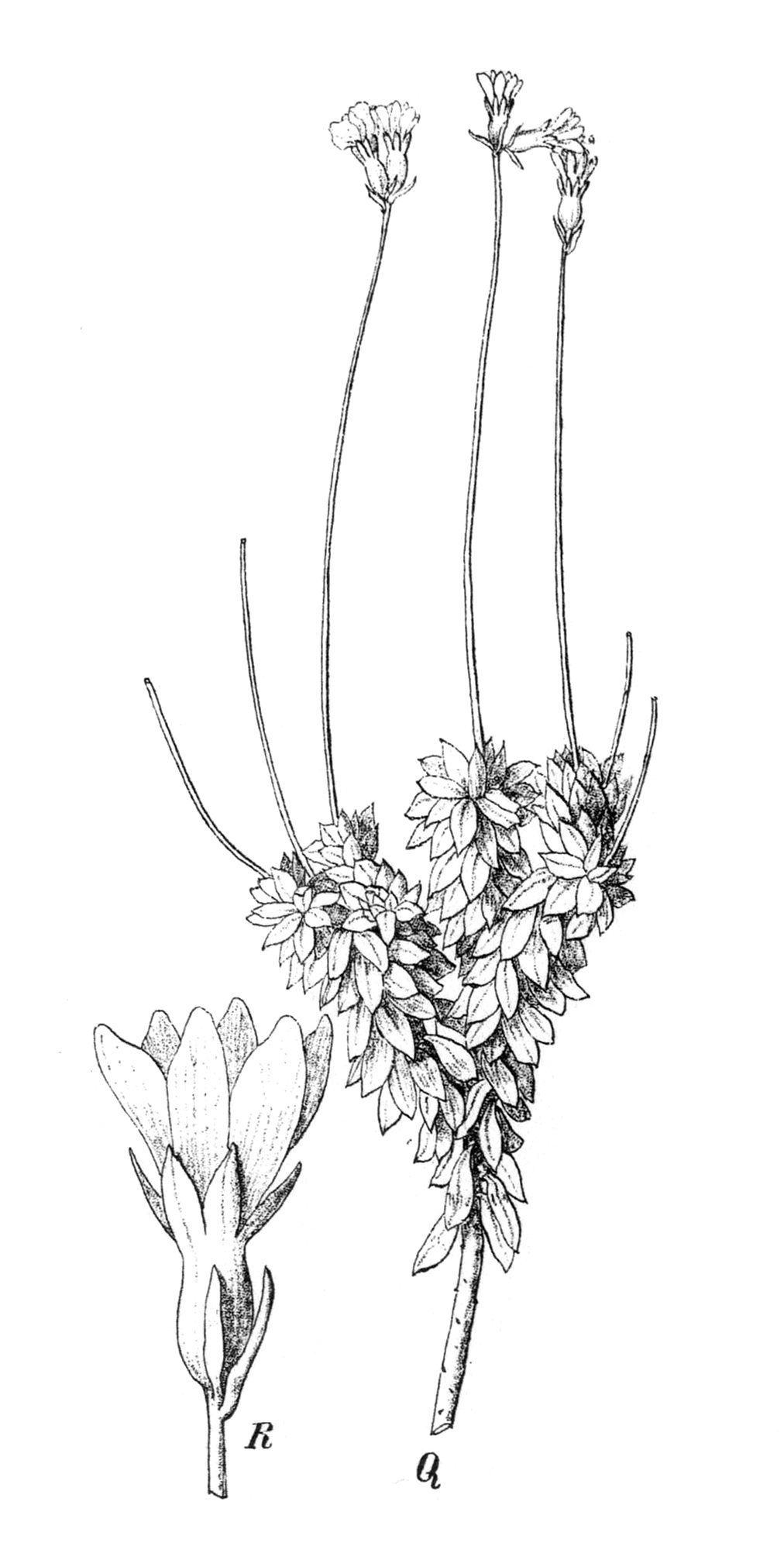- Forstera
Taxobox
name = "Forstera"

image_caption = "Forstera bidwillii " illustration fromJohannes Mildbraed 's 1908 monograph on the Stylidiaceae.
regnum =Plant ae
divisio = Magnoliophyta
classis =Magnoliopsida
ordo =Asterales
familia =Stylidiaceae
genus = "Forstera"
genus_authority =L.f. 1780
type_species = "Forstera sedifolia "
type_species_authority = L.f.
subdivision_ranks =Species
subdivision = "Forstera bellidifolia " "Forstera bidwillii " "Forstera mackayii " "Forstera sediflora " "Forstera tenella ""Forstera" is a genus of small
perennial plant s in theStylidiaceae family named in honour of the German naturalistsJohann Reinhold Forster and his son,Georg Forster , who had previously described "Forstera"'s sister genus, "Phyllachne " just five years earlier. It is comprised of 5 species that are endemic toNew Zealand with the exception of "F. bellidifolia", which is endemic toTasmania . The species in this genus resemble those in asubgenus of the related genus "Stylidium " called "Forsteropsis", but they are more closely related to the genus "Phyllachne". Proposals to merge the two genera based on information from cladistic analysis have emerged because of these genera's morphological similarities and evidence that they are paraphyletic.Description
The species in "Forstera" are generally erect or decumbent perennials with small imbricate leaves and pedicellate, actinomorphic flowers.Good, R. (1925). [http://www.blackwell-synergy.com/action/showPdf?submitPDF=Full+Text+PDF+%287%2C170+KB%29&doi=10.1111%2Fj.1469-8137.1925.tb06666.x&cookieSet=1 On the geographical distribution of the Stylidiaceae] . "New Phytologist", 24(4): 225-240.]
"Forstera" and its closely allied sister genus "
Phyllachne " have often been regarded as the mostplesiomorphic genera in their family. Characteristics that this genus shares with "Phyllachne" include apically fused thecae that form a single-celled curvedanther and theepigynous nectaries. "Forstera" can be distinguished from "Phyllachne" by its longpeduncle (absent in "Phyllachne") and thecushion plant habit of "Phyllachne".Laurent, N., Bremer, B., Bremer, K. (1998). Phylogeny and generic interrelationships of the Stylidiaceae (Asterales), with a possible extreme case of floral paedomorphosis. "Systematic Botany", 23(3): 289-304.]Botanical history
The genus "Forstera" was first described in 1780 by
Carolus Linnaeus the Younger in "Nova Acta Regiae Societatis Scientiarum Upsaliensis ", though his authorship is disputed by theAustralian Plant Name Index (APNI). Many sources listL.f. (Linnaeus the Younger's standard author abbreviation) as the author of the genus, but the APNI notes that "no mention of Linnaeus as author could be found." [http://www.anbg.gov.au/cgi-bin/apx?taxon_id=47498 "Forstera" L.f.]Australian Plant Name Index . Accessed online: 3 October 2007.] The first species placed in the genus was "F. sedifolia", which would remain the only species in the genus for 72 years. The English botanist SirJoseph Dalton Hooker described three new species: "F. bellidifolia" in 1852 and "F. bidwillii" and "F. tenella" in 1853.Mildbraed, J. (1908). Stylidiaceae. In: Engler, A. "Das Pflanzenreich: Regni vegetabilis conspectus". IV. 278. Leipzig.]There was an uncertaintly among botanists whether these plants belonged in one genus or two. The first instance of such uncertainty began when
Ferdinand von Mueller moved "F. sedifolia" and "F. bellidifolia" to "Phyllachne" in 1874. In 1889, Selmar Schönland reduced the genus itself to a section of "Phyllachne" under the name "Phyllachne" sect. "Forstera" in Engler and Prantl's "Die Natürlichen Pflanzenfamilien ". The moves established what later taxonomists would come to realize: that these two genera are closely related. ByJohannes Mildbraed 's 1908 taxonomicmonograph on the family in Engler's "Das Pflanzenreich ", all four species known at the time were placed back into "Forstera". The last species in this genus to be described was "F. mackayii" in 1935 byHarry Howard Barton Allan , bringing the total to five species.References
Wikimedia Foundation. 2010.
